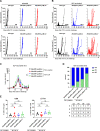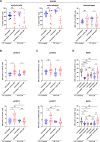IL-6 signaling in macrophages is required for immunotherapy-driven regression of tumors
- PMID: 33879600
- PMCID: PMC8061866
- DOI: 10.1136/jitc-2021-002460
IL-6 signaling in macrophages is required for immunotherapy-driven regression of tumors
Abstract
Background: High serum interleukin (IL-6) levels may cause resistance to immunotherapy by modulation of myeloid cells in the tumor microenvironment. IL-6 signaling blockade is tested in cancer, but as this inflammatory cytokine has pleiotropic effects, this treatment is not always effective.
Methods: IL-6 and IL-6R blockade was applied in an IL-6-mediated immunotherapy-resistant TC-1 tumor model (TC-1.IL-6) and immunotherapy-sensitive TC-1.
Control: Effects on therapeutic vaccination-induced tumor regression, recurrence and survival as well on T cells and myeloid cells in the tumor microenvironment were studied. The effects of IL-6 signaling in macrophages under therapy conditions were studied in Il6rafl/fl×LysMcre+ mice.
Results: Our therapeutic vaccination protocol elicits a strong tumor-specific CD8+ T-cell response, leading to enhanced intratumoral T-cell infiltration and recruitment of tumoricidal macrophages. Blockade of IL-6 signaling exacerbated tumor outgrowth, reflected by fewer complete regressions and more recurrences after therapeutic vaccination, especially in TC-1.IL-6 tumor-bearing mice. Early IL-6 signaling blockade partly inhibited the development of the vaccine-induced CD8+ T-cell response. However, the main mechanism was the malfunction of macrophages during therapy-induced tumor regression. Therapy efficacy was impaired in Il6rafl/fl×LysMcre+ but not cre-negative control mice, while no differences in the vaccine-induced CD8+ T-cell response were found between these mice. IL-6 signaling blockade resulted in decreased expression of suppressor of cytokine signaling 3, essential for effective M1-type function in macrophages, and increased expression of the phagocytic checkpoint molecule signal-regulatory protein alpha by macrophages.
Conclusion: IL-6 signaling is critical for macrophage function under circumstances of immunotherapy-induced tumor tissue destruction, in line with the acute inflammatory functions of IL-6 signaling described in infections.
Keywords: CD8-Positive T-Lymphocytes; active; adaptive immunity; immune evation; immunotherapy; macrophages.
© Author(s) (or their employer(s)) 2021. Re-use permitted under CC BY-NC. No commercial re-use. See rights and permissions. Published by BMJ.
Conflict of interest statement
Competing interests: None declared.
Figures






Similar articles
-
PD-1 blockade synergizes with intratumoral vaccination of a therapeutic HPV protein vaccine and elicits regression of tumor in a preclinical model.Cancer Immunol Immunother. 2021 Apr;70(4):1049-1062. doi: 10.1007/s00262-020-02754-x. Epub 2020 Oct 27. Cancer Immunol Immunother. 2021. PMID: 33108473 Free PMC article.
-
CXCR6 deficiency impairs cancer vaccine efficacy and CD8+ resident memory T-cell recruitment in head and neck and lung tumors.J Immunother Cancer. 2021 Mar;9(3):e001948. doi: 10.1136/jitc-2020-001948. J Immunother Cancer. 2021. PMID: 33692218 Free PMC article.
-
Mannose-Modified Liposome Co-Delivery of Human Papillomavirus Type 16 E7 Peptide and CpG Oligodeoxynucleotide Adjuvant Enhances Antitumor Activity Against Established Large TC-1 Grafted Tumors in Mice.Int J Nanomedicine. 2020 Dec 1;15:9571-9586. doi: 10.2147/IJN.S275670. eCollection 2020. Int J Nanomedicine. 2020. PMID: 33293808 Free PMC article.
-
CXCL9-expressing tumor-associated macrophages: new players in the fight against cancer.J Immunother Cancer. 2021 Feb;9(2):e002045. doi: 10.1136/jitc-2020-002045. J Immunother Cancer. 2021. PMID: 33637602 Free PMC article. Review.
-
Biological effects of IL-15 on immune cells and its potential for the treatment of cancer.Int Immunopharmacol. 2021 Feb;91:107318. doi: 10.1016/j.intimp.2020.107318. Epub 2020 Dec 28. Int Immunopharmacol. 2021. PMID: 33383444 Review.
Cited by
-
IL-2-loaded liposomes modified with sorafenib derivative exert a synergistic anti-melanoma effect via improving tumor immune microenvironment and enhancing antiangiogenic activity.Asian J Pharm Sci. 2025 Apr;20(2):101020. doi: 10.1016/j.ajps.2025.101020. Epub 2025 Jan 10. Asian J Pharm Sci. 2025. PMID: 40475279 Free PMC article.
-
Tumor-associated macrophages contribute to cisplatin resistance via regulating Pol η-mediated translesion DNA synthesis in ovarian cancer.Cell Mol Life Sci. 2025 May 29;82(1):220. doi: 10.1007/s00018-025-05731-8. Cell Mol Life Sci. 2025. PMID: 40437303 Free PMC article.
-
Cancer-associated fibroblasts shape early myeloid cell response to chemotherapy-induced immunogenic signals in next generation tumor organoid cultures.J Immunother Cancer. 2024 Nov 4;12(11):e009494. doi: 10.1136/jitc-2024-009494. J Immunother Cancer. 2024. PMID: 39500527 Free PMC article.
-
Biomimetic "Gemini nanoimmunoregulators" orchestrated for boosted photoimmunotherapy by spatiotemporally modulating PD-L1 and tumor-associated macrophages.Acta Pharm Sin B. 2024 Mar;14(3):1345-1361. doi: 10.1016/j.apsb.2023.11.005. Epub 2023 Nov 4. Acta Pharm Sin B. 2024. PMID: 38486995 Free PMC article.
-
Emergency myelopoiesis in solid cancers.Br J Haematol. 2024 Sep;205(3):798-811. doi: 10.1111/bjh.19656. Epub 2024 Jul 23. Br J Haematol. 2024. PMID: 39044285 Free PMC article. Review.
References
Publication types
MeSH terms
Substances
LinkOut - more resources
Full Text Sources
Other Literature Sources
Medical
Research Materials
